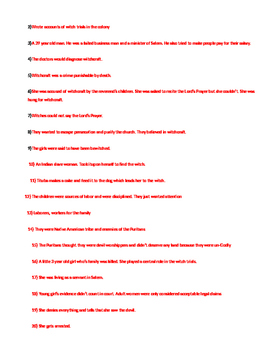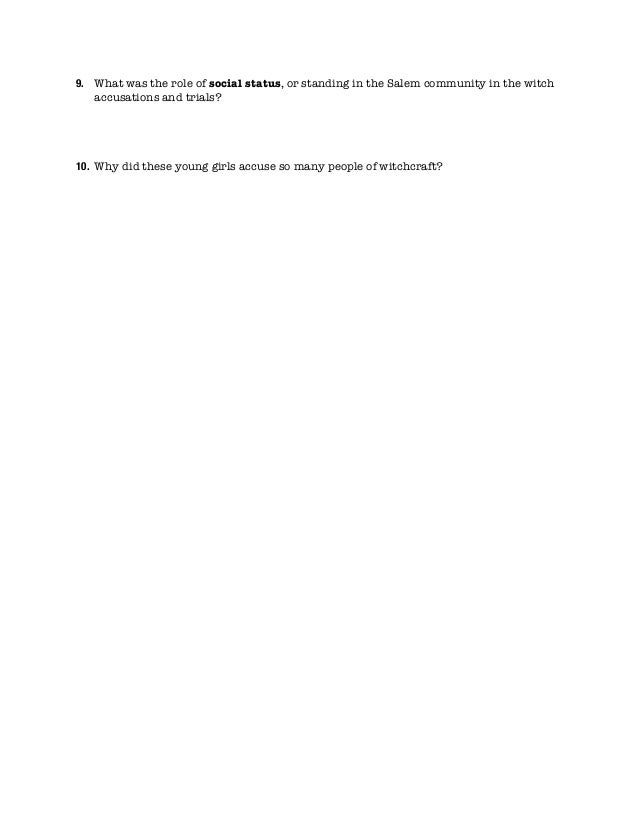
The History Channel Salem Witch Trials Video Guide Answer Key
The infamous Salem witch trials began during the spring of 1692, after a group of young girls in Salem Village, Massachusetts, claimed to be possessed by the Shows This Day In History. Gundam battle universe psp english patch.
Understanding the Salem Witch Trials Salem, Massachusetts in 1691 was the home of a Puritan community with a strict moral code. In addition to the difficulties of farming in a harsh climate with rough terrain, Salem faced economic and political unrest. In this community, a group of girls accused an Indian slave named Tituba of witchcraft. Tituba confessed under pressure from court officials, and her confession ignited a hunt for witches that left 19 men and women hanged, one man pressed to death, and over 150 more people in prison awaiting a trial. In this lesson, students will explore the characteristics of the Puritan community in Salem, learn about the Salem Witchcraft Trials, and try to understand how and why this event occurred.
Guiding Questions. Salem, Massachusetts in the late 1600s faced a number of serious challenges to a peaceful social fabric. Salem was divided into a prosperous town and a farming village.

The villagers, in turn, were split into factions that fiercely debated whether to seek ecclesiastical and political independence from the town. In 1689 the villagers won the right to establish their own church and chose the Reverend Samuel Parris, a former merchant, as their minister. His rigid ways and seemingly boundless demands for compensation increased the already present friction. Many villagers vowed to drive Parris out, and they stopped contributing to his salary in October 1691.
• ordered a few thousand Mini Uzi and Uzi carbines in 1990s. Testi po uzi diagnostike video. It was made from Israeli-supplied (and later Rhodesian-made) components.
These local concerns only compounded the severe social stresses that had already been affecting New England for two decades. A 1675 conflict with the Indians known as King Philip's War had resulted in more deaths relative to the size of the population than any other war in American history. A decade later, in 1685, King James II's government revoked the Massachusetts charter. A new royally-appointed governor, Sir Edmund Andros, sought to unite New England, New York, and New Jersey into a single Dominion of New England. He tried to abolish elected colonial assemblies, restrict town meetings, and impose direct control over militia appointments, and permitted the first public celebration of Christmas in Massachusetts, a celebration of which Puritans strongly disapproved.
After William III replaced James II as King of England in 1689, Andros's government was overthrown, but Massachusetts was required to eliminate religious qualifications for voting and to extend religious toleration to sects such as the Quakers. The late seventeenth century also saw a increase in the number of black slaves in New England, which further unsettled the existing social order. In February 1692, Betty Parris, Reverend Parris's daughter, as well as her friends Abigail Williams and Ann Putnam, became ill with symptoms that doctors could not diagnose, including fits and delirium.
Griggs, who attended to the 'afflicted' girls, suggested that they might be bewitched. Mercy Lewis, Mary Walcott, and Mary Warren later claimed affliction as well. Prodded by Parris and others, the girls named their tormentors: Sarah Good, a poor woman; Sarah Osbourn, an elderly woman; and Tituba, a slave who had told them stories involving Vudou beliefs. The women were tried for witchcraft - Good and Osbourn claimed innocence, and Tituba confessed. Tituba's detailed confession included a claim that there were several undiscovered witches who wanted to destroy the community. This caused a witch-hunting rampage: 19 men and women were hanged, one man was pressed to death, and over 150 more people were imprisoned, awaiting trial.
On September 22, 1692, the last eight alleged witches were hanged. On October 8, 1692, Governor Phipps ordered that spectral evidence (when someone claimed to witness a person's spirit in a separate location from that same person's physical body) could no longer be admitted in witchcraft trials. On October 29, 1692 Phipps prohibited further arrests and released many accused witches. The remaining alleged witches were pardoned by May 1693. The hangings of witches in 1692 were the last such hangings in America.
For more information, see the following EDSITEment-reviewed websites: • • • •. • Review the lesson plan. Locate and bookmark suggested materials and other useful websites.